

- Call 908 543 4390
- Email
- Dr.Joni Redlich PT,DPT


Many children struggle with coordination for various reasons, ranging from sensory processing differences to cerebral palsy to dyspraxia/developmental coordination disorder (DCD). Often, there is no identified cause, the coordination trouble can have a real impact on our children’s lives. Regardless of the cause, there are numerous ways to support children in becoming active and improving their coordination. It’s important to recognize that coordination issues typically do not resolve on their own; the belief that children will “grow out of it” is often inaccurate. Instead of relying on the “wait and see” approach, here are actionable tips to help children build confidence, self-esteem, and an active lifestyle now and in the future.
These individual sports help improve body awareness, sensory processing, and balance. They’re sensory-rich and can be modified for individual differences. Structured activities like martial arts and swimming provide repetitive movements that enhance coordination and control. These activities also promote discipline and focus, essential components for children with coordination challenges. 🥋🏊♂️
Explore fun, social, and noncompetitive activities like hiking, yoga, and creative movement. These activities are enjoyable and help develop coordination in a relaxed setting, encouraging children to participate without the pressure of competition. They also offer opportunities for social interaction and sensory exploration, which are beneficial for children with coordination difficulties. 🌳🧘♀️
Encourage timing development with music and movement opportunities. Activities like dancing or playing musical instruments can enhance a child’s sense of rhythm and timing, which are crucial for coordinated movements. Engaging with music can also be a joyful and expressive outlet, providing both physical and emotional benefits. 🎶🎤
Adapt the environment for success with picture schedules, written lists, and typing instead of writing. These adaptations help children manage tasks more efficiently and reduce frustration, creating a more supportive learning environment. Using tools like pencil grips or raised line paper can also help children with fine motor challenges. 📋🖥️
Practice listening, looking, and moving simultaneously with games like “I Spy” during walks. This helps children improve their ability to process multiple stimuli simultaneously, enhancing their overall coordination. Such activities also promote cognitive flexibility and attention to detail. 👀🚶♂️
Model the use of feedback during play to bring awareness to the process and encourage improvement. For example, if you practice shooting a basketball with your child, bring attention to when you throw too hard, too soft, too high, or too low. Help your child notice these things and how to adapt next time they throw. Positive reinforcement and constructive feedback are crucial in this learning process. 🏀🎯
Help your child learn tasks by starting with the last step and working backwards to build independence. This technique makes complex tasks more manageable and less overwhelming for children with coordination difficulties. It allows them to experience success early and gradually build confidence and competence. 🔄
Use supports like yoga wedges or towel rolls to help your child sit upright. If your child is a wiggler when sitting for fine motor or reaching activities, they might need support for their core to feel stable. Proper sitting posture aids in better focus and coordination during activities that require fine motor skills. 🧘♂️
If your child often falls out of their chair or trips frequently, they may have postural imbalances that hinder their ability to develop core strength and better coordination. A screening with a specialized physical therapist can identify these issues and provide targeted interventions to address them. Early intervention can lead to quicker progress and improved overall function. 🤾♀️
Partner with a PT or OT specialist to lay a strong foundation for movement, ensuring more effective and successful practice. Professional guidance provides tailored strategies to address your child’s specific needs and promote better coordination. Regular sessions with a therapist can help monitor progress and adjust strategies as needed. 👋
Supporting a child with coordination troubles requires patience, encouragement, and the right strategies. By incorporating these tips into your daily routine, you can help your child build confidence, improve their skills, and enjoy a more active and fulfilling life. Remember, every child is unique, so it’s important to tailor your approach to what works best for them.
Kid PT, dedicated to helping children thrive, provides expert pediatric occupational and physical therapy to support children with coordination difficulties. Contact us to learn more about our personalized programs and how we can help your child reach their full potential and request a free screening HERE.
For more detailed strategies and insights, consider reading Joni Redlich’s book, “Turn Stumbling Blocks Into Building Blocks,” which offers a comprehensive movement blueprint for children with developmental challenges or request a free sample sent to your inbox HERE.

When parents first notice their baby’s head tilting to one side or they prefer to always look in one direction, the diagnosis might be torticollis—a common yet often misunderstood condition in infants. Torticollis is commonly considered to involve a tightening of the neck muscles, causing the head to tilt. While some might consider it a straightforward problem that just needs a bit of stretching, the reality is far more complex, especially for a developing infant. Let’s dig a little deeper.
The Misunderstanding of Treatment:
It’s a common misconception that pediatricians or even adult care providers can manage torticollis with simple neck stretches given in person, on a handout, or with a YouTube clip. This approach vastly underestimates the intricacies of the condition. Torticollis isn’t just about one tight muscle; it involves an intricate interplay of the neuromuscular system, as the baby learns how to look around at their environment, feed, and explore movement. Without the right expertise, there’s often a lack of comprehensive treatment, which can lead to long-term consequences for your child. In fact, research has shown that earlier referral to a specialist is much more effective than home base treatment based on handouts or video instruction. Without specialist care that addresses the body as a whole, babies with torticollis are at risk for sensory processing problems, balance deficits, coordination issues and even scoliosis in the future. Even with apparent resolution of the neck position and preference, without comprehensive care, these children are often back seeking physical therapy or occupational therapy care during the preschool or school aged years to deal with the risks previously discussed, that could have been prevented with comprehensive specialist care during infancy.
The Need for Specialist Intervention:
Here’s why seeing a specialist—like a pediatric physical therapist or a pediatric occupational therapist—is critical:
Long-term Benefits of Specialist Care:
Choosing specialist care might seem like a significant investment, but it’s one that offers substantial returns. Properly managed torticollis not only prevents physical complications like asymmetry of the face or skull but also ensures that your child’s motor milestones, such as rolling over, crawling, and walking, are not delayed. It sets up your child with the opportunity to develop solid sensory processing skills and good balance and coordination to serve them for a lifetime. Ultimately, investing in specialist care can prevent costlier interventions later in life.
Conclusion:
Torticollis in infants requires more than just basic care; it demands expert attention. As a parent, ensuring your child receives the best possible treatment is paramount. By choosing a specialist who understands the complexities of infant development, you’re not just addressing a temporary tilt in your child’s head—you’re setting up your child for a healthier, well-aligned future.
If you notice any signs of torticollis in your baby, don’t wait. Contact a pediatric specialist who can provide the care that’s right for your child’s long-term health and development. Remember, when it comes to your child’s growth, every detail counts, and the right care early on can make all the difference.
Looking for tips to get started with today? Then download a copy of our free expert report – A Parent’s Guide To Torticollis – which contains 5 stress-free strategies to solve stubborn head tilts & turns.
Autism is a complex neurodevelopmental condition characterized by challenges in social interaction, communication, and repetitive behaviors. While the focus of autism research often revolves around therapies and interventions to address these core symptoms, research and clinical experience has shown how important the movement system is both affected is a subset of autistic people, and how addressing it can support autistic children in all areas of their lives. In this blog post we’re going to discuss a specific aspect of movement: EXERCISE!
Emerging evidence suggests that incorporating exercise into the lives of individuals with autism can yield profound benefits. In this article, we delve into the relationship between autism and exercise, drawing insights from both research studies and practical experiences.
Understanding Autism and Exercise: Autism manifests differently in each individual, presenting a diverse array of strengths and challenges. However, common features such as sensory sensitivities, motor coordination difficulties, and heightened anxiety levels can impact an individual’s engagement in physical activities. As a result, exercise programs tailored to accommodate these specific needs are essential for promoting the overall well-being of individuals with autism.
In his seminal work “Understanding Autism Through Exercise,” Dr. Michael Thompson emphasizes the importance of structured exercise routines in improving the physical and psychological health of individuals on the autism spectrum. Drawing from his extensive clinical experience, Dr. Thompson highlights how regular exercise can help alleviate sensory overload, enhance motor skills, and reduce anxiety levels among individuals with autism.
Research Insights: Several studies have investigated the effects of exercise on individuals with autism, shedding light on its potential therapeutic benefits. A study conducted by Smith et al. (2020) explored the impact of a 12-week exercise intervention on the social skills and physical fitness of children with autism. The results revealed significant improvements in both social interaction abilities and physical fitness levels, underscoring the positive effects of structured exercise programs on multiple domains of functioning.
Similarly, a randomized controlled trial by Chen et al. (2018) examined the effects of a yoga intervention on the behavior and emotional regulation of adolescents with autism. The findings demonstrated that participants who engaged in regular yoga sessions exhibited reductions in disruptive behaviors and improvements in emotional self-regulation compared to the control group, highlighting the therapeutic potential of mind-body interventions for individuals with autism.
Furthermore, a meta-analysis conducted by Lee et al. (2019) synthesized findings from multiple studies investigating the effects of exercise on cognitive function in individuals with autism. The meta-analysis revealed a significant positive effect of exercise on cognitive outcomes, including attention, executive function, and academic performance, suggesting that physical activity interventions hold promise for enhancing cognitive abilities in this population.
Practical Implications: Integrating exercise into the daily routine of individuals with autism requires a tailored approach that considers their unique needs and preferences. Activities such as swimming, cycling, yoga, and martial arts can provide opportunities for physical fitness while also addressing sensory sensitivities and promoting social interaction. Taking walks before school or taking the dog for a walk together after school can help fit exercise into your daily routine. Additionally, incorporating visual schedules, sensory supports, and structured routines can help individuals with autism feel more comfortable and confident during exercise sessions. At Kid PT, our Active Video Game program has been an awesome way to combine a love for gaming with exercise!
The relationship between autism and exercise is a multifaceted one, with emerging research highlighting the potential therapeutic benefits of structured physical activity interventions. By understanding the unique challenges faced by autistic and implementing tailored exercise programs, we can empower them to lead healthier, more active lives. As we continue to unravel the complexities of autism, integrating exercise as a fundamental component of holistic care can contribute to the overall well-being and quality of life of individuals on the autism spectrum.
If you are think you may need more supoprt putting these exercise ideas into action, don’t worry, we got you. It’s natural to wonder how to apply this to your individual child. That’s why we’re extending a heartfelt invitation for you to access our expertise at no cost. For a limited time, KidPT is proud to offer a Free Autism Fit Consult. Our expert team is dedicated to understanding the uniqueness of your child’s development and providing tailored strategies to support their growth and development. During the consult, we’ll evaluate your child’s current skills and discuss with you goals for the future. We’ll sit down with you, listen to your concerns, and discuss a plan with actionable steps.
Seize this opportunity for an Autism Fit Consult and be proactive in supporting your child’s developmental journey. Click HERE or reach out to us at 908 543 4390 to reserve your spot and embrace the possibilities.
Together, let’s help your child stand proud, move freely, and live vibrantly.
Schedule Your Free Autism Fit Consult
Read our blog – What Does Movement Have to do with Autism
Download our expert report, Core Strengthening for Kids
On social media? Then Like Our Facebook Page or Follow Us On Instagram for more helpful tips and advice.
References:

April is a special time at Kid PT, filled with an extra dose of heart and celebration. It’s Autism Awareness and Acceptance Month, and just like family, we come together to honor and uplift the wide spectrum of neurodiversity that enriches our lives.
Here at Kid PT, neuro-affirmative care is more than a concept—it’s the heartbeat of our practice. It’s the commitment we strive to live by, as we welcome neurodivergent and autistic individuals through our doors every week. It’s a promise to value, support, and celebrate each unique individual, not for what the world wants them to be, but for the wonderful person they already are.
April at Kid PT is not just a time for celebration and education; it’s also an opportunity for us to acknowledge the real and often challenging daily experiences of parents raising autistic children. We recognize that while there is immense joy and pride in supporting your child’s unique journey, there are also moments of uncertainty, worry, and fatigue. These challenges are a significant part of the journey for many families, and it’s crucial that they are met with understanding, support, and resources.
Neuro-affirmative care, the cornerstone of our practice, is about more than just understanding and supporting autistic individuals—it’s also about extending our care and resources to their families. We’re here to provide a supportive community and practical strategies to help parents navigate the complexities of life with autism. From sharing insights and knowledge to offering a listening ear, our goal is to ensure that no parent feels they are walking this path alone.
Let’s dig into neuro-affirmitive care, discuss why adopting a neuro-affirmative care model for autistic children and adults matters and let’s integrate insights from life experience, literature and cutting-edge research.
Neuro-affirmative care starts with the recognition that autism is not a deficit but a difference. This perspective encourages us to appreciate the unique strengths and abilities that autistic individuals bring to our communities and workplaces. For instance, many autistic people exhibit remarkable attention to detail, deep focus on subjects of interest, and original thinking. By fostering an environment that values these strengths, we can unlock the potential of autistic individuals, promoting both personal fulfillment and valuable contributions to society.
A cornerstone of neuro-affirmative care is the promotion of understanding and acceptance. Traditional approaches often focus on making autistic individuals conform to societal norms, which can be both distressing and damaging. In contrast, neuro-affirmative care seeks to educate society about autism, challenging stereotypes and misconceptions. This broader understanding can lead to greater acceptance, reducing stigma and creating more inclusive communities where differences are celebrated rather than feared.
Neuro-affirmative care recognizes the immense variability within the autism spectrum, emphasizing the importance of personalized support strategies. This approach involves working closely with autistic individuals to identify their specific needs, preferences, and goals. Whether it’s in educational settings, the workplace, or daily life, individualized strategies can help autistic people navigate challenges while leveraging their strengths. For example, sensory-friendly environments and flexible communication methods can significantly improve quality of life and accessibility.
Rather than imposing external goals, neuro-affirmative care focuses on building upon the intrinsic motivations and interests of autistic individuals. This approach acknowledges that engagement and learning are most effective when they align with an individual’s passions. Educational and therapeutic programs designed around personal interests not only foster a deeper level of engagement but also encourage the development of skills and knowledge in a way that feels rewarding and meaningful.
Finally, neuro-affirmative care places a strong emphasis on supporting the emotional and social well-being of autistic individuals. Recognizing and validating the emotional experiences of autistic people, including the challenges they face, is essential. Supportive relationships and networks, alongside strategies to navigate social interactions in a way that respects individual needs and boundaries, can significantly enhance well-being and quality of life.
The benefits of neuro-affirmative care for autistic children and adults are profound and far-reaching. By embracing a model of care that values diversity, promotes acceptance, and tailors support to individual needs, we can create a society that truly appreciates the unique contributions of every individual, including those who are autistic. As we observe Autism Awareness and Acceptance Month, let us commit to advancing neuro-affirmative care and building a more inclusive world for all.
If you are think you may need more supoprt putting these neuro-afffirming concepts into action, don’t worry, we got you. Its natural to worry whether you’re giving your child the best supports for their needs. That’s why we’re extending a heartfelt invitation for you to access our expertise at no cost. For a limited time, KidPT is proud to offer a Free Action Plan Consult. Our expert team is dedicated to understanding the uniqueness of your child’s development and providing tailored strategies to support their growth and development. During the consult, we’ll evaluate your child’s current skills and discuss with you goals for the future. We’ll sit down with you, listen to your concerns, and discuss a plan with actionable steps.
Seize this opportunity for an Action Plan Consult and be proactive in supporting your child’s developmental journey. Click HERE or reach out to us at 908 543 4390 to reserve your spot and embrace the possibilities.
Together, let’s help your child stand proud, move freely, and live vibrantly.
Schedule Your Free Action Plan Consult
Read our blog – CELEBRATING NEURODIVERSITY WITH CHILDREN’S BOOKS
Download our expert report, Sensory Smart Parenting
On social media? Then Like Our Facebook Page or Follow Us On Instagram for more helpful tips and advice.
Children with ADHD often face a myriad of challenges beyond what meets the eye. While attention deficits and hyperactivity are commonly recognized symptoms, let’s delve into five lesser-known issues that can significantly impact a child’s daily life: interoception, balance, constipation, vision, and executive function. In this blog post, we’ll explore each of these under-recognized issues and how specialized pediatric occupational therapy and physical therapy can offer effective interventions to support children with ADHD. These challenges aren’t just areas of concern; they’re opportunities for improvement that can enhance your child’s self-esteem, confidence, and ability to tackle challenges head-on.

We all know about our 5 senses, but there are also internal senses that tell us about our bodies, how they feel, and how they move. One of those internal senses is called Interoception. This refers to the ability to perceive internal bodily sensations, such as hunger, thirst, and the need to use the bathroom. Many children with ADHD struggle with interoception, leading to difficulties in recognizing and responding to their body’s signals. This can result in irregular eating habits, dehydration, and challenges with self-regulation.
Think about a time that you were hangry! If our children are feeling hungry or thirsty, and are not skilled at feeling and interpreting those messages from their bodies, focussing on a teacher or playing with a friend can be really difficult.
The good news is that specialized therapy techniques, such as sensory integration activities and mindfulness exercises, can help improve interoceptive awareness and promote better self-management skills. A great resource to learn more about interception is Kelley Mahler’s website here. Our therapists at Kid PT use the Interception Curriculum she has developed to support our children’s improved awareness of their sensory awareness from the inside out.
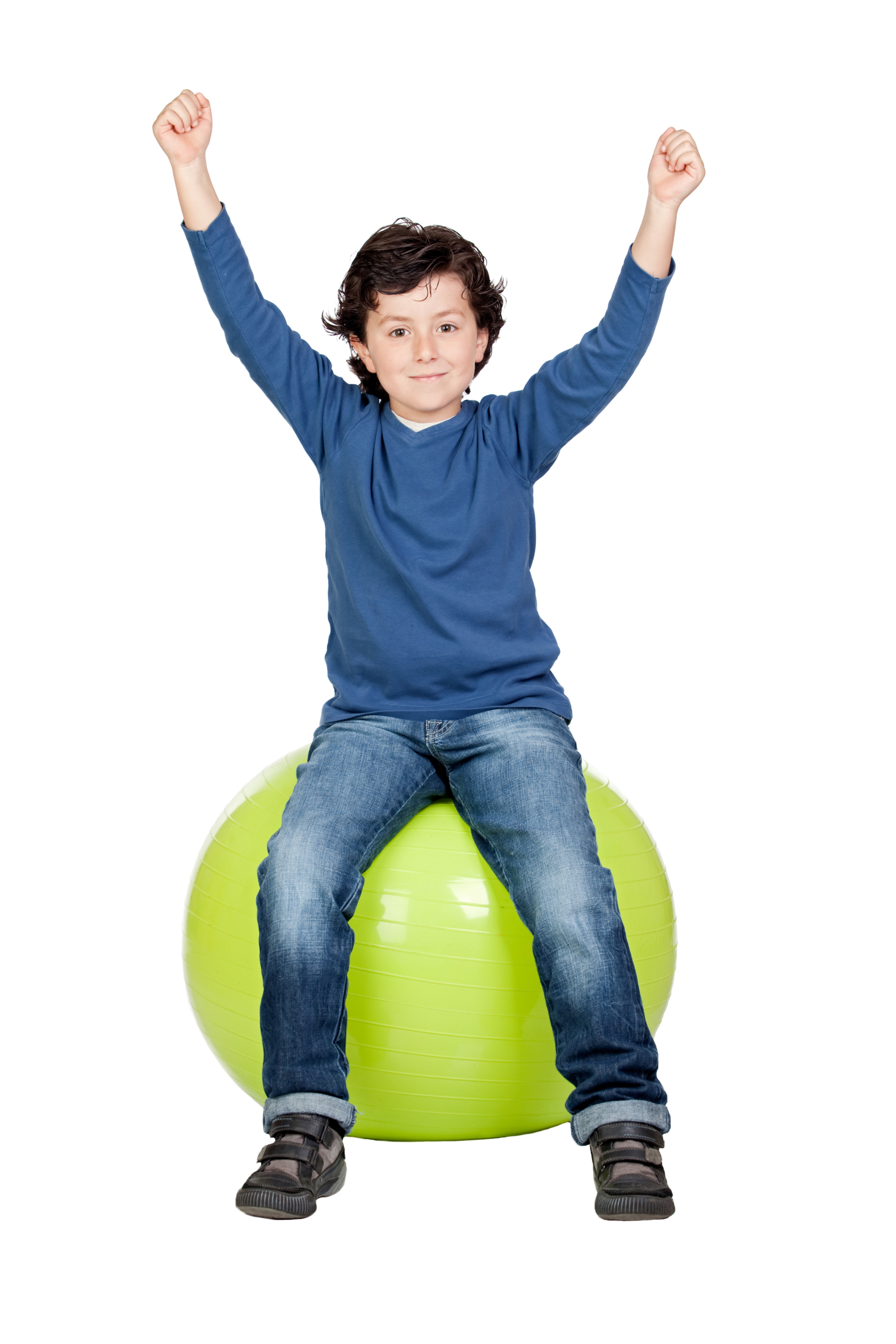
Maintaining balance and coordination is essential for daily activities and participation in sports and recreational activities. It even impact the classroom setting, as children need to have the postural control to separate their eyes from their head and bodies, while listening and learning at the same time. However, children with ADHD often experience difficulties with balance, which can affect their confidence and overall physical well-being. Through targeted physical therapy interventions, such as balance training exercises and vestibular stimulation, children can enhance their balance skills and reduce the risk of falls and injuries.
So often we assume that our children who are always moving must have good balance and gross motor skills. Often children with ADHD have learned from experience that moving slowly, or not moving at all, is REALLY hard to control and that if they just keep moving, they can control their bodies much better. This lack of mature postural control skills can impact children in so many areas, from academic to social.
Is your child always falling out of their chair or only moving quickly? Read more about what may be going on here and here.
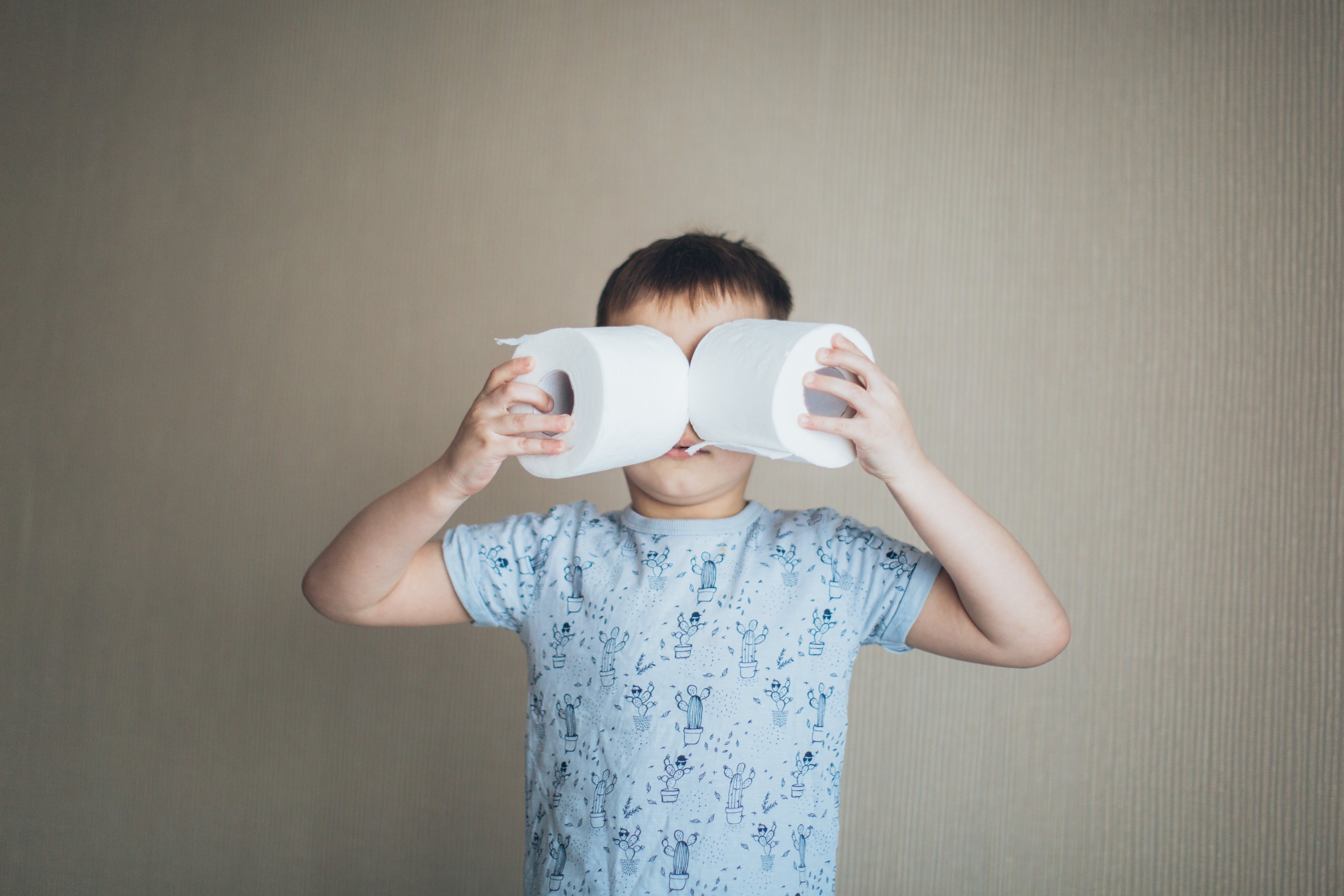
Constipation is a commonly overlooked issue in children with ADHD, yet it can have a significant impact on their quality of life. Poor dietary habits, medication side effects, postural asymmetries and reduced physical activity levels may contribute to constipation in this population. Again, this is an often overlooked issue, but one that impacts our children’s everyday life and health. Pediatric occupational therapists and physical therapists can collaborate with healthcare providers to develop tailored interventions, including dietary modifications, bowel management strategies, and sensory-based techniques to address constipation and promote bowel regularity.
Our physical therapists at Kid PT have learned over and over again working with children with various diagnoses that improving their postural symmetry and control, has impacted the child’s constipation or reflux. This is often overlooked, but even minor problems in the core can impact the pressure system for things to effortless move up and down in the body’s systems.
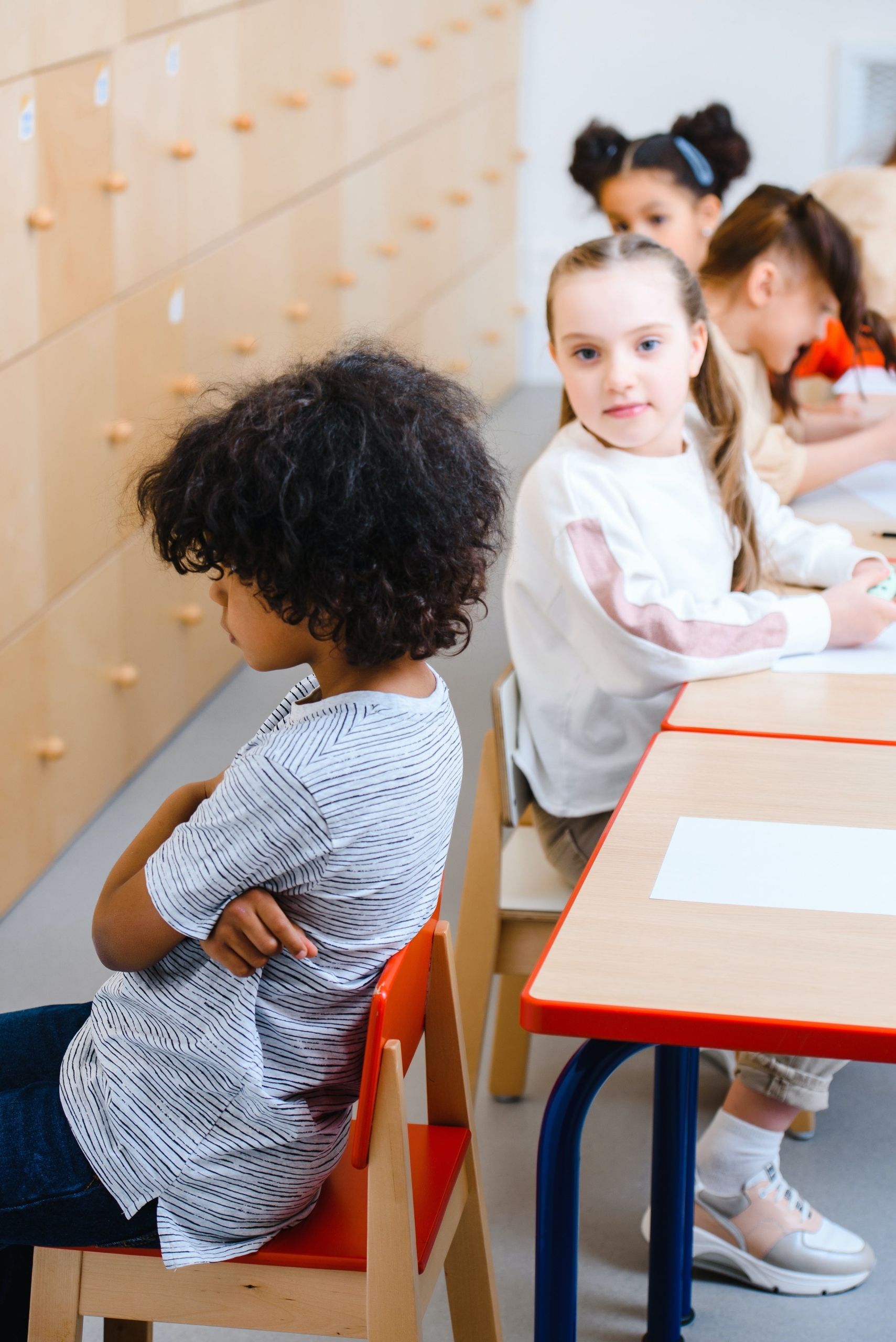
Visual processing difficulties are prevalent among children with ADHD and can manifest as challenges with tracking, focusing, and visual perception. Undiagnosed vision problems may exacerbate academic struggles and hinder overall performance in school. Vision challenges can impact a child’s school life, success playing sports, and even social interactions.
Both occupational therapy and physical therapy can work on taking those visual challenges, and put it into action by working on not only the function of the eyes, but getting vision coordinated and in sync with the other sensory systems and the body too.
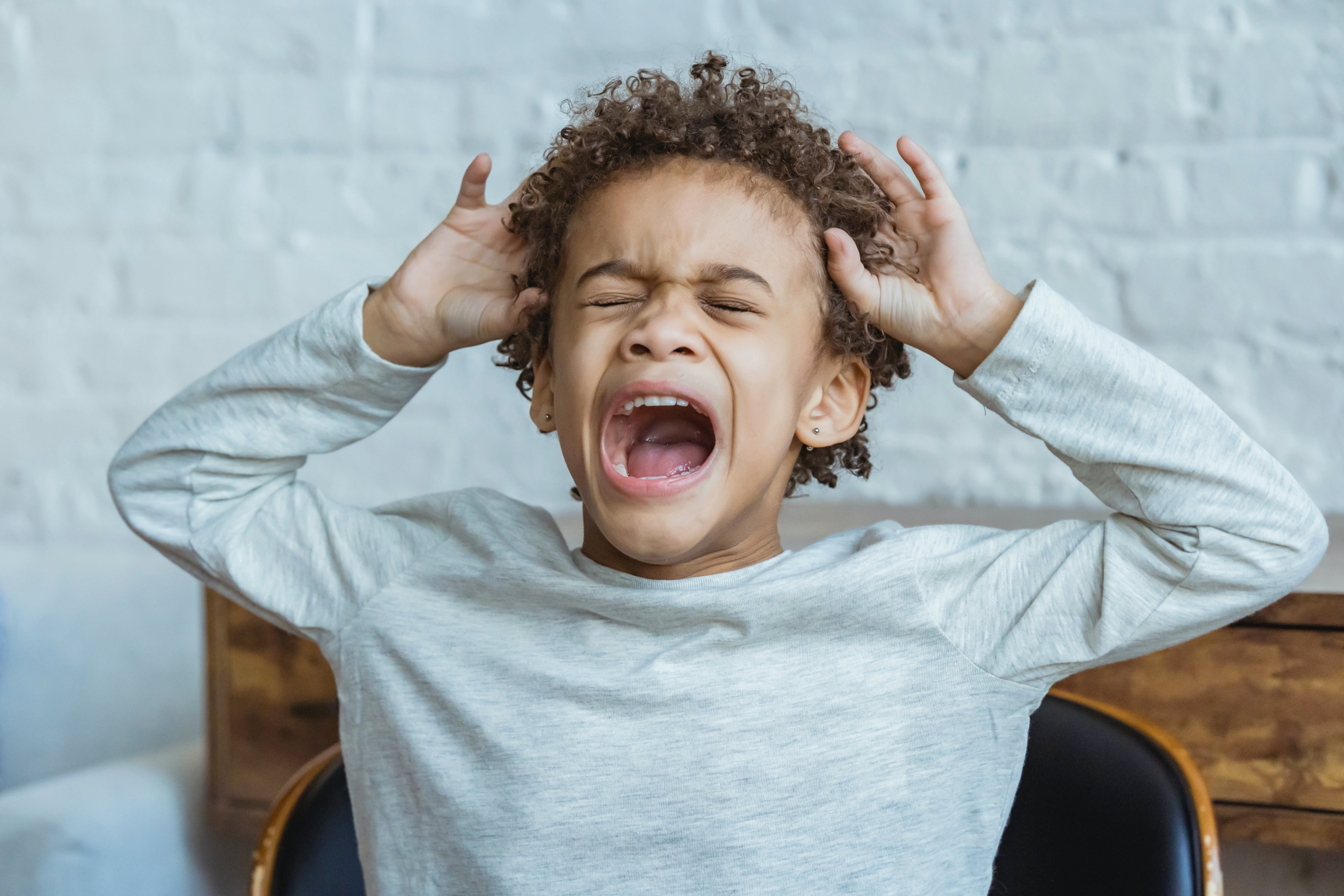
Executive function encompasses a range of cognitive processes involved in goal-directed behavior, such as planning, working memory, organization, and flexible thinking. Children with ADHD often exhibit weaknesses in executive function, which can impact their academic performance, social interactions, and daily functioning. If your child is often frustrated or seems inflexible, this may be an area of weakness. Additionally, it the parenting strategies that work for your other children, just don’t work for your child with ADHD, this will likely be why.
The occupational therapists can evaluate each component of a child’s executive function and sensory processing skills to develop a comprehensive individualized plan to support the child. Specialized interventions, such as cognitive-behavioral strategies, organizational skills training, and guided sensory motor experiences, can help improve executive function skills and enhance overall adaptive functioning in children with ADHD.

While ADHD presents its share of well-known challenges, it’s essential to recognize and address the often overlooked issues that significantly impact children’s lives. Interoception, balance, constipation, vision, and executive function problems can all pose significant barriers to children with ADHD, but with specialized pediatric occupational therapy and physical therapy, these challenges can be improved in ways that can improve your child’s confidence and self-esteem, leading them to more success now and in the future. By raising awareness of these underrecognized issues and providing targeted interventions, we can empower children with ADHD to reach their full potential and lead fulfilling lives.
If you’ve noticed your child seems a step behind, or perhaps they tire easily, struggle with coordination, or find it hard to keep up with their peers, it’s natural to feel concerned. That’s why we’re extending a heartfelt invitation for you to access our expertise at no cost. For a limited time, KidPT is proud to offer an ADHD Insight Screening. Our expert team is dedicated to understanding the unique melody of your child’s development and providing tailored strategies to harmonize their abilities with their ambitions. During the screening, we’ll evaluate your child’s balance, vision, and executive function skills. We’ll sit down with you, listen to your observations, and address your worries with actionable steps. Seize this opportunity for a ADHD Insight Screening and be proactive in supporting your child’s developmental journey. Click HERE or reach out to us at 908-543-4390 to reserve your spot and embrace the support your child deserves.
Together, let’s help your child feel confident, in control, and living their best lives.
Schedule Your Free Development ADHD Screening
Read our blog – Quick Kids: It Might be More Than Behavior or Attentions
Read a sample of Dr. Joni;s book – Turn Stumbling Blocks Into building Blocks
On social media? Then Like Our Facebook Page or Follow Us On Instagram for more helpful tips and advice.
As parents, we pour our hearts and souls into nurturing our young athletes.
We drive them to practice, cheer them on from the sidelines, and invest countless hours and resources into their sporting endeavors.
We do it all because we believe in our children’s potential and their dreams, and we want to see them succeed. But when our young athletes face repeated injuries, it can be a devastating blow to both them and us.
The emotional rollercoaster that comes with watching our children experience pain, setbacks, and the frustration of being sidelined can be overwhelming.
We understand the dedication and sacrifices involved in raising young athletes, and we also understand the heartache that comes with seeing them struggle.
However, there is hope, and in this blog, we’ll explore how to prevent repeated injuries in young athletes so that they can continue pursuing their passions with confidence and resilience.
Repeated injuries can have a profound impact on the physical and emotional well-being of young athletes.
It’s not just about the immediate pain and discomfort; it’s about the long-term consequences that can affect their athletic careers and even their quality of life.
Here’s how repeated injuries can affect our young athletes:
1. Physical Limitations:
Each injury can leave a lasting mark on the athlete’s body, potentially reducing their performance capabilities and flexibility.
This physical toll can hinder their ability to compete at their best.
2. Psychological Impact:
Young athletes may experience feelings of frustration, anxiety, and even depression due to repeated injuries.
They may question their abilities and lose the confidence they once had in their skills.
3. Lost Opportunities:
Time spent recovering from injuries is time away from practice and competition.
Repeated injuries can rob young athletes of crucial opportunities to improve and showcase their talents.
4. Strained Relationships:
The stress of dealing with injuries can strain relationships within the family and with coaches and teammates.
The pressure to perform can lead to misunderstandings and conflicts.
Now, let’s dive into the heart of the matter: how can we prevent repeated injuries in our young athletes? Here are five essential tips that will help safeguard their physical and emotional well-being:
1. Physical Therapy – The Foundation of Injury Prevention:
As a physical therapist, I can’t emphasize enough the importance of incorporating regular physical therapy into your young athlete’s routine.
A skilled therapist can assess their physical condition, identify areas of weakness or imbalance, and design a customized plan to strengthen their body and prevent injuries.
Physical therapy not only aids in recovery but also provides essential guidance on proper conditioning and techniques to reduce the risk of injuries in the first place.
2. Rest and Recovery:
In the quest for greatness, young athletes often push themselves to the limit.
However, it’s crucial to recognize the value of rest and recovery.
Overtraining and inadequate rest can lead to injuries.
Encourage your child to listen to their body, take regular rest days, and prioritize sleep to allow their muscles and joints to recuperate.
3. Balanced Nutrition:
A well-balanced diet is the fuel that young athletes need to perform at their best and stay injury-free.
Ensure your child gets the right mix of nutrients, including protein, carbohydrates, vitamins, and minerals.
A nutritionist can provide personalized guidance to support their growth, development, and overall health.
4. Proper Warm-Up and Cool Down:
Teach your young athlete the importance of warming up before practice or competition and cooling down afterward.
A proper warm-up prepares the body for physical activity, while a cool-down routine helps prevent muscle stiffness and injury.
Make stretching and mobility exercises a non-negotiable part of their training regimen.
5. Diversify Training and Sports:
While specialization in a single sport can lead to skill development, it can also increase the risk of overuse injuries.
Encourage your child to participate in multiple sports and engage in cross-training.
This not only keeps them physically versatile but also reduces the strain on specific muscle groups.
If you’ve noticed that your young athlete is struggling to keep up with their peers, experiencing coordination issues, or facing challenges with their physical performance, it’s completely natural to be concerned.
That’s why we’re extending a warm invitation for you to tap into our expertise, and best of all, it won’t cost you a thing.
For a limited time, KidPT is thrilled to offer a Free Performance Assessment for Young Athletes.
Our expert team is dedicated to understanding the unique rhythm of your young athlete’s development and providing customized strategies to enhance their athletic abilities.
During the assessment, we’ll evaluate your young athlete’s physical strength, coordination, and overall performance.
We’ll sit down with you, listen to your observations, and address any concerns with practical steps and guidance.
Take advantage of this opportunity to schedule a Free Performance Assessment for Young Athletes and take a proactive approach to support your child’s athletic journey.
Click HERE or contact us at 908 543 4390 to secure your spot and provide the support your young athlete deserves.
Together, let’s empower your young athlete to perform at their best, move with agility, and excel in their sports endeavors.
Schedule Your Free Development Screening for Young Athletes’ Performance.
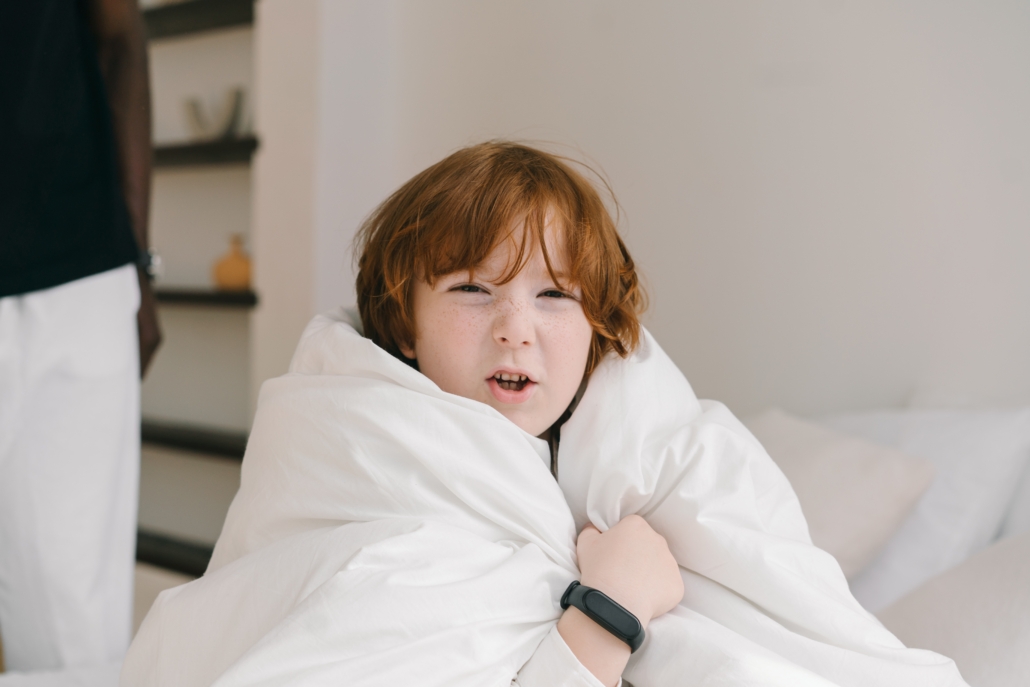
“He will only wear the same outfit EVERY SINGLE DAY!”
“The second he comes home from school he takes all of his clothes off!”
“She refuses to wear socks! What do I do now that summer is over?”
These are things we hear everyday from parents calling us at Kid PT to ask for help. There are many strategies our Occupational Therapists have to guide you and your child through these challenges, but one step can be to find clothing that is more tolerable to our children who are more sensory sensitive.
Choosing the right clothing for autistic children can greatly impact their comfort and confidence as they head back to school. Sensory-friendly and adaptive clothing can make a significant difference. Here are 8 autism-friendly clothing brands that prioritize comfort and style for a successful back-to-school experience:
Tommy Hilfiger’s Adaptive line features clothing with hidden magnetic closures, adjustable features, and easy-to-use fastenings. These modifications promote independence while maintaining a trendy appearance.
SmartKnitKIDS specializes in seamless, irritation-free clothing that is perfect for children with sensory sensitivities. Their seamless socks, underwear, and tees minimize discomfort and sensory challenges.
Mabel’s Labels not only offers practical name labels but also a collection of sensory-friendly clothing. Their tagless shirts and adaptive features cater to children’s unique needs, reducing sensory triggers.
Target’s Cat & Jack Adaptive line combines style with functionality. Their sensory-friendly designs, adaptive closures, and soft materials provide children with autism a comfortable and fashionable back-to-school wardrobe.
Primary offers a range of clothing in solid colors without distracting logos or tags. These simple designs can be particularly appealing to children with sensory sensitivities, providing a hassle-free clothing option.
BILLY Footwear specializes in adaptive shoes with a unique zipper system that makes them easy to put on and take off. Their stylish and inclusive designs accommodate various needs.
ABLE2WEAR focuses on clothing that addresses specific mobility and sensory needs. From open-back tops to easy-to-dress pants, their adaptive options cater to a variety of challenges that children on the autism spectrum may face.
We know that the right clothing won’t solve all of the challenges in your daily routine, but it could make a big difference. These brands prioritize sensory comfort, functionality, and style, allowing students to confidently navigate their school day while feeling their best.
Have you tried any of these brands yet?
If so, please share your story. Let us know your likes and dislikes to help parents who are in similar shoes as you.

Sleep plays a vital role in the overall well-being and development of adolescents. However, many teenagers struggle with sleep-related issues due to factors such as academic stress, digital engagement, and changing biological rhythms. The Occupational Therapists (OTs) at Kid PT can play a crucial role in helping adolescents establish healthy sleep patterns through targeted interventions. Parents have told us over and over again that when they apply these strategies and their teens are sleeping better, the entire family feels happier and healthier.
1. Sleep Hygiene Education
OTs can educate adolescents about the importance of consistent sleep schedules, comfortable sleep environments, and the negative effects of excessive screen time before bed. Teaching them good sleep hygiene practices empowers them to make informed choices about their sleep routine.
2. Mindfulness and Relaxation Techniques
Teaching relaxation techniques such as deep breathing, progressive muscle relaxation, and guided imagery can help adolescents manage stress and anxiety that might interfere with their sleep. These techniques promote a calm and relaxed state conducive to falling asleep.
3. Sensory Regulation Activities
Incorporating sensory-based activities into the daily routine can help adolescents transition to a more relaxed state before bedtime. Activities like soft lighting, calming scents, and gentle tactile experiences can signal the body that it’s time to wind down.
4. Physical Activity Integration
Encouraging regular physical activity during the day can contribute to better sleep at night. OTs can suggest appropriate exercises that align with an adolescent’s interests and energy levels, promoting physical fatigue that aids in falling asleep more easily.
5. Cognitive Behavioral Strategies
OTs can teach adolescents cognitive strategies to address negative thought patterns that might keep them awake at night. By challenging and reframing these thoughts, adolescents can develop a healthier mindset towards sleep.
6. Sleep Journaling
Keeping a sleep journal helps adolescents track their sleep patterns and identify potential triggers for sleep disturbances. This collaborative approach enables OTs to tailor interventions to address specific sleep challenges.
7. Technology Management
Adolescents often engage with screens late into the night, affecting their sleep-wake cycle. OTs can work with them to establish digital curfews and develop strategies to wind down without screen exposure in the hour before bedtime.
8. Routine Development
Consistency is key to regulating sleep. OTs can collaborate with adolescents to develop personalized bedtime routines that signal the body that it’s time to sleep. These routines can include calming activities, such as reading or listening to soothing music.
9. Environmental Modifications
Creating a sleep-conducive environment is crucial. OTs can provide recommendations for adjusting lighting, noise levels, and bedding to create a comfortable and calming space for sleep.
10. Family Involvement
Engaging parents and caregivers is essential for successful sleep regulation. OTs can educate families about the importance of sleep and provide them with strategies to support their adolescents in maintaining a consistent sleep schedule.
Pediatric OTs have a valuable role to play in helping adolescents regulate their sleep patterns. By employing a combination of sleep hygiene education, relaxation techniques, sensory interventions, and cognitive strategies, OTs can empower adolescents to overcome sleep-related challenges and develop healthier sleep habits. Through collaborative efforts with adolescents and their families, OTs can contribute to improved overall well-being and quality of life for adolescents.
Do you want to learn more about how the OTs at Kid PT can help things finally get better in your home? Email info@kidpt.com or Call Us at (908) 543-4390 and schedule a free phone consult to discuss what is going on and how we can help.
Occupational therapy (OT) helps people of all ages to improve their ability to perform daily activities, also known as “occupations.”
What does this have to do with children then?
Well, what is the “occupation” of children? PLAY!
Occupational therapists (OTs) work with individuals who have conditions that affect their ability to perform activities of daily living, such as physical or cognitive disabilities, injuries, or illnesses. The goal of occupational therapy is to help individuals achieve independence and improve their quality of life. This may include activities such as dressing, bathing, eating, and using the toilet, as well as more complex tasks like work and leisure activities. Occupational therapists may also work with individuals to improve their fine motor skills, coordination, and balance.
In the pediatrics world, OTs work in a variety of settings, such as early intervention, outpatient clinics, and schools. They work with children with a variety of needs and diagnoses, including autism, hypotonia, sensory processing disorder, and genetic disorders.
Our occupational therapists at Kid PT work with children on a wide variety of ways.
Kid PT’s occupational therapists, Disha and Nina, have an endless supply of creative solutions to improve all of the areas of a child’s sensory, motor and emotional development. We love to integrate children’s interests into their therapy sessions as well. An engaged child is a learning child!
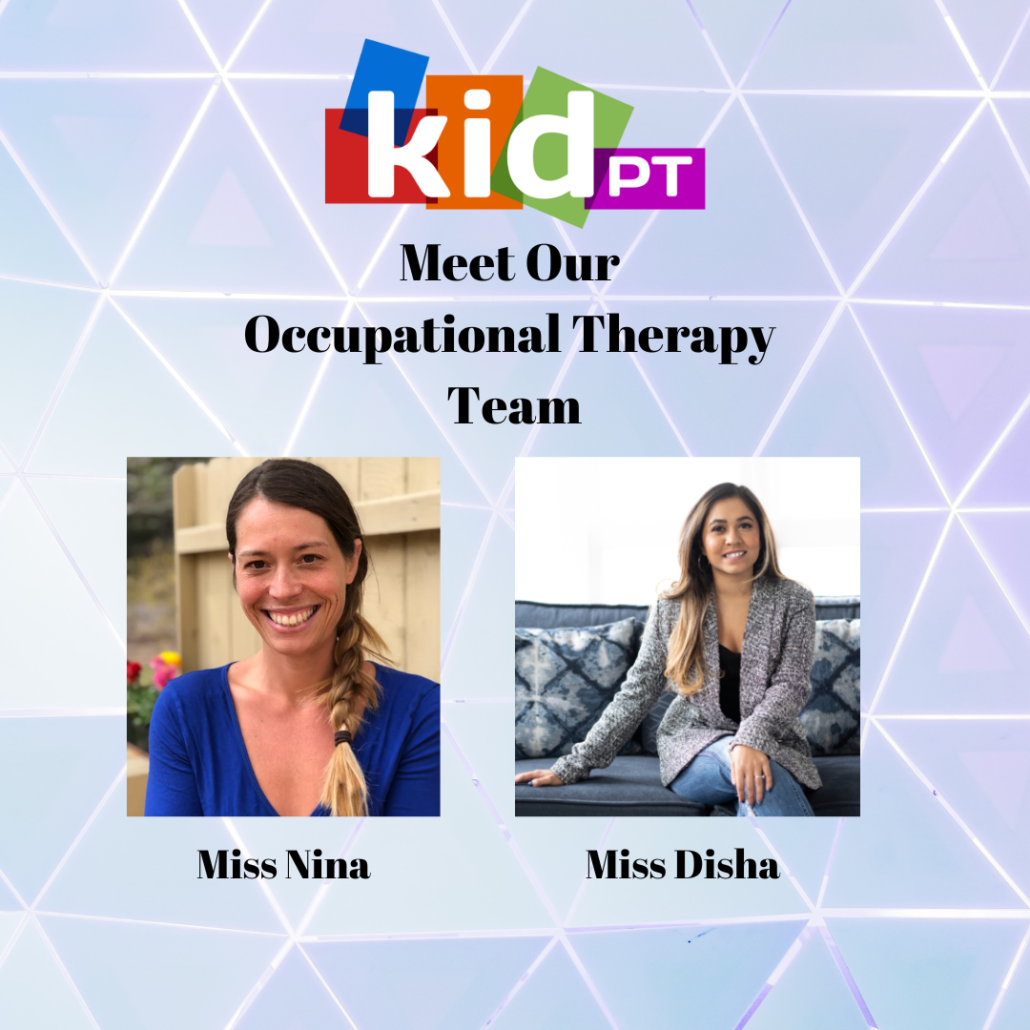
Remember, ask your child’s therapist for individual recommendations, but here is a good jumping off point for you!
Playdough is a fun and versatile material that can be used to improve fine motor skills in children. Children can use their fingers to squeeze, roll, and shape the playdough, which can help to improve their dexterity, hand-eye coordination, and strength in the fingers and hands. They can even experiment with squishing it with their feet and toes too!
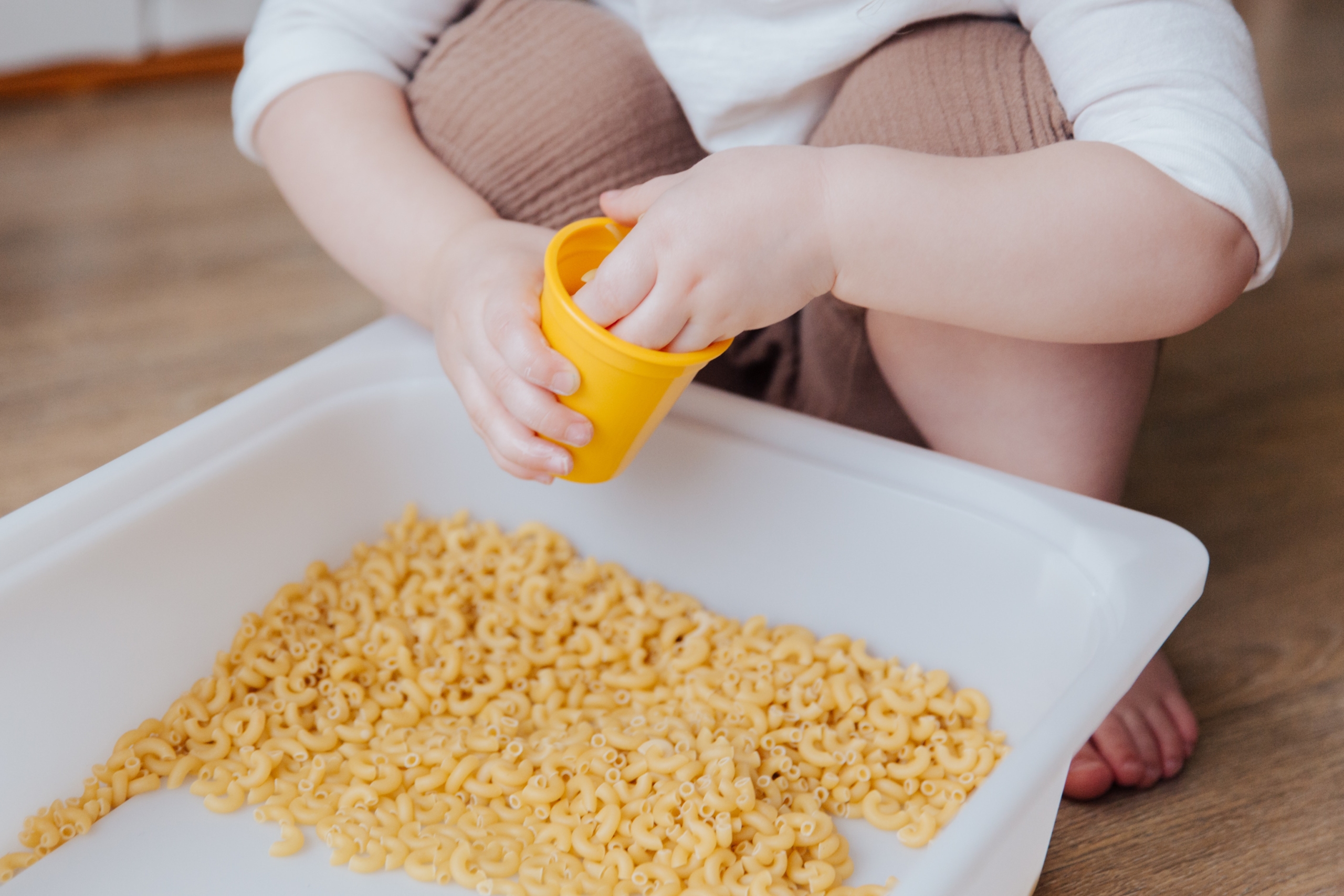
Fill a container with cooked spaghetti, raw beans, or rice. Use cups to fill and empty, hide sea creatures in it, and have fun! This activity helps improve fine motor control, hand-eye coordination, and sensory processing.
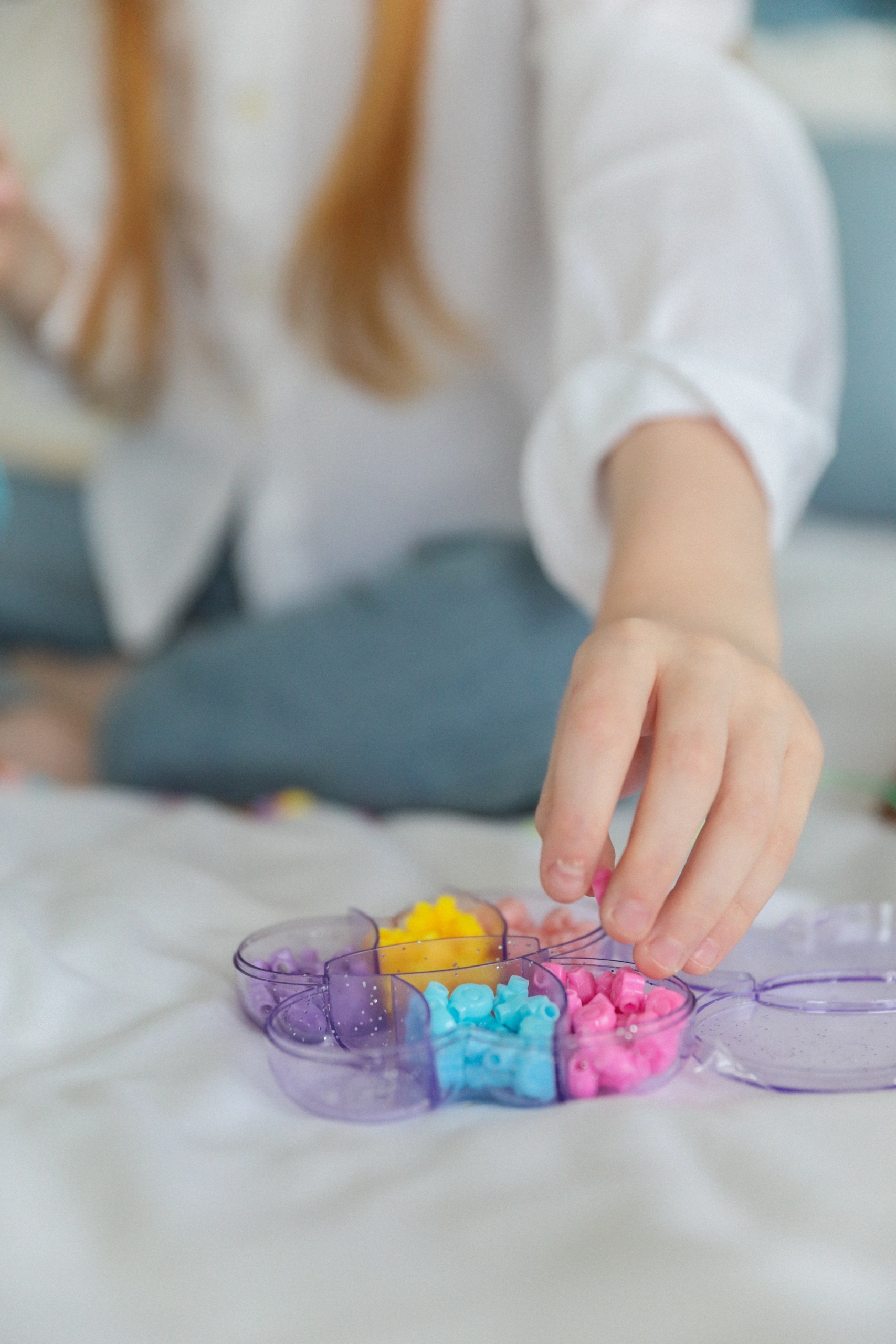
Beading is a fun and engaging way to improve fine motor skills in children. Children can string beads of different shapes and sizes onto a string or pipe cleaner, which can help to improve their dexterity, hand-eye coordination, and strength in the fingers and hands.


Building with legos or any other small building blocks can be a great way to improve fine motor skills in children. It requires children to use their fingers to pick up small blocks and place them in the correct spot, which can help to improve their dexterity, hand-eye coordination, and strength in the fingers and hands.

Outdoor games such as tag, capture the flag, and soccer, which involve running, jumping, and coordination.
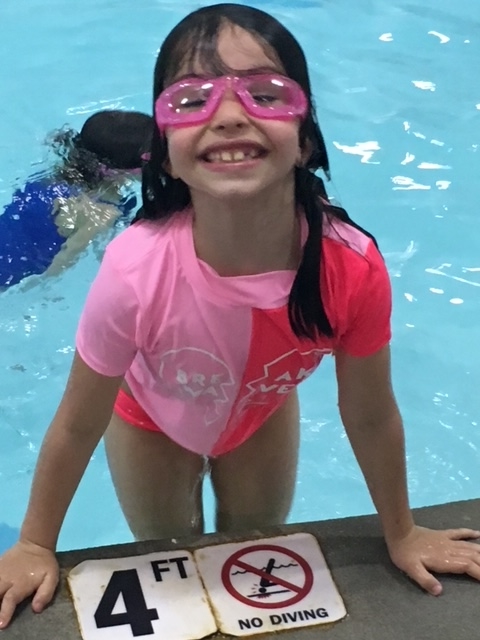
Swimming, which improves balance, coordination and endurance.
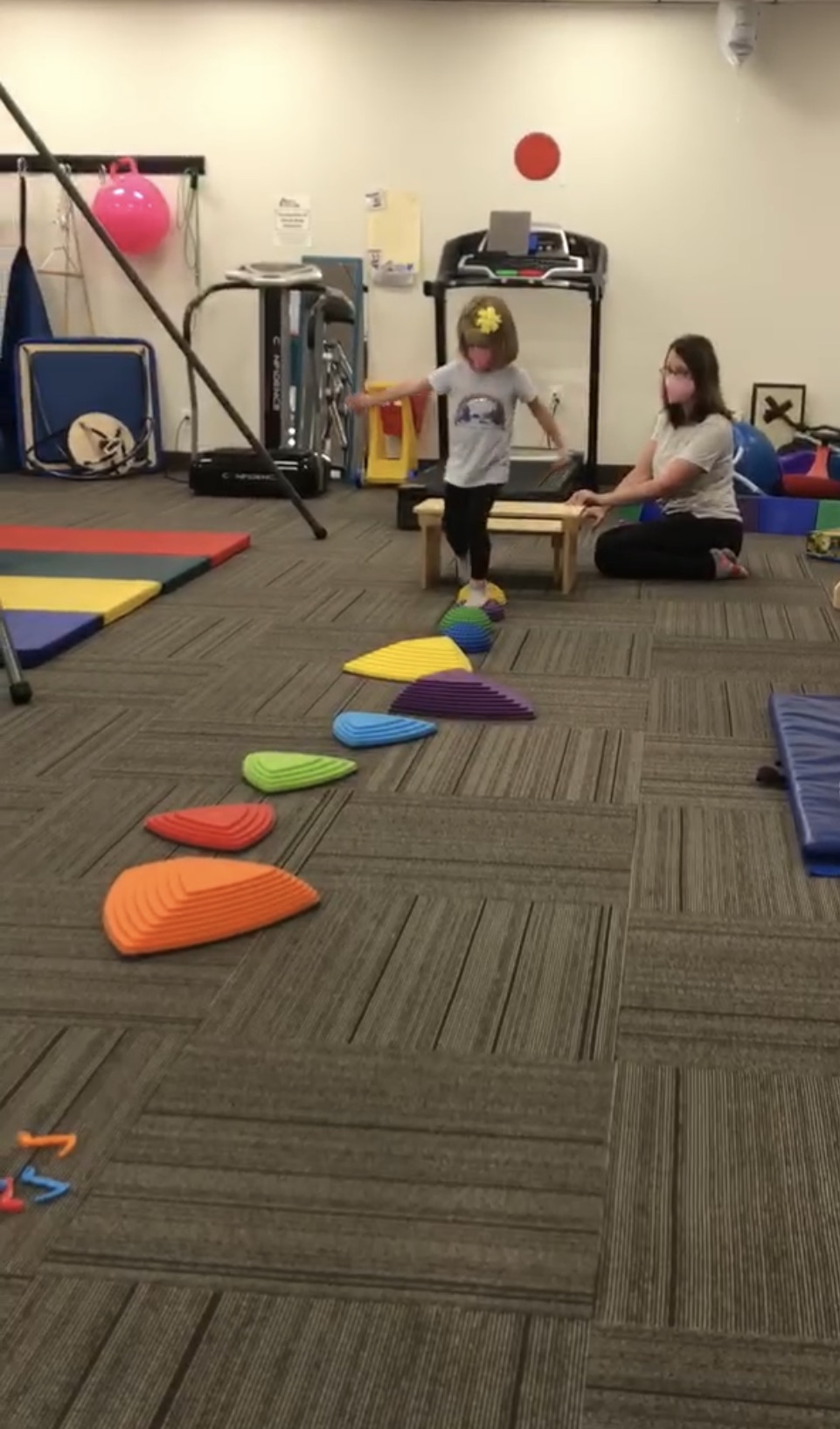
Obstacle courses, which involve crawling, jumping, and climbing, and help to develop strength and coordination.
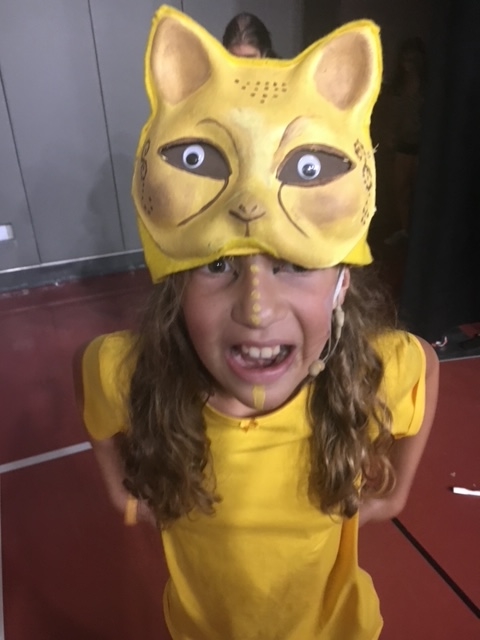
Dress up and role play, where children can act out different scenarios and characters using costumes and props.
Setting up a store, where children can pretend to be the cashier, customer, or salesperson, working on their math skills, social skills, and creativity.

Sand and water play, which can help children to develop their sense of touch and sense of proprioception (awareness of the position of their body in space)

Cooking and baking activities, which can help to develop children’s sense of smell, taste, and touch.
Remember to have fun, ask your child’s OT for advice on how to bring their therapy home into your daily routine!

Babies have just spent 9 months growing and developing in the womb, where they were just floating around!
As newborns, they are fully reliant on mom and dad to support where their bodies go and what they see, hear, touch and smell.
With practice, new experiences, and time, babies develop head control through a combination of increased muscle strength and coordination. As they grow, infants begin to control the movements of their head by strengthening the muscles in their neck, upper back, and throughout their bodies. They also learn to coordinate the movement of their head with their eyes, which allows them to fixate on objects and track movement. This stimulates the development of the vision system, which also develops as a result of movement experiences. Additionally, as babies spend time lying on their backs, lying on their stomachs, and even being carried, they have the opportunity to practice lifting and controlling their head movements.

Babies typically begin to hold their heads up by themselves around 3-4 months of age. This is a significant milestone in their development, as it indicates that they are gaining control over the muscles in their neck and upper back. However, it’s important to note that all babies develop at different rates, and some may start holding their heads up earlier or later than others. Some babies may be able to hold their heads up briefly as early as 2 months, while others may not be able to hold their heads up until they are 5 months old. It is important to also be mindful if a baby was born prematurely. We want to consider the skills of a baby who was born prematurely in comparison with their adjusted age and not just their chronological age.
It’s important to remember that skills will develop as babies have the opportunity to try out new skills. That means that babies need lots of time to experiment with movement! The best way to do that is on the floor on a blanket with both toys (consider black and white toys or cards for our youngest of babies) and also with us. Get down on the floor with baby to play and if there is a big brother or sister, have then get in on the action too. If you have barriers to getting down on the floor to play, you can do the same play activities on a couch where you can be sitting more comfortably.

Here are our Kid PT top 3 positions that can be helpful for babies to strengthen their necks:

If your baby is struggling to hold their head up during tummy time or prefers to look in one direction, it is best to seek out professional advice. At Kid PT, Dr. Joni always tells parents that when they come in for a free screening they will either learn how to help their child or they will get piece of mind that everything is ok. There is nothing to lose!
To learn more about the developmental process in the first year and understand what to expect as your little one learns to move, check out Dr. Joni’s free guide, The 6 Keys to Gross Motor Development In the First Year. The goal of this guide is to help parents find out when their baby just needs more time and when their baby may need some help to meet their milestones!
If your worries about your baby’s development are keeping you up at night (and we know how precious sleep is right now!), then we would like to invite you to come in for a Discovery Visit to meet with one of Kid PT’s physical therapists. At a Discovery Visit, we will talk about your concerns and make a look at your baby’s movement skills.
You can request for a free visit HERE.
Do you want to learn more about pediatric physical therapy and what it is. You can read more about it here. I know as a parent it can scary to take your baby to a new medical appointment. Rest assured that our visits are generally filled with smiles, giggles, and play. Babies have no idea they’re “working”, but just know they’re having fun. In fact, one of our top values at Kid PT is for the therapeutic process to be not just effective from a movement perspective, but for it to be as easy and positive as can be along the journey.
If you have any questions, we are here for you. You can call us at (908) 543-4390 or email Dr. Joni directly at joni@kidpt.com.
Just remember parents, you go this!

